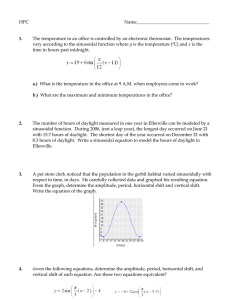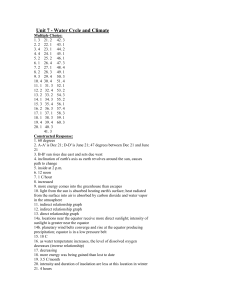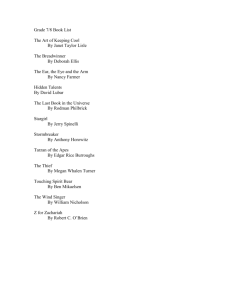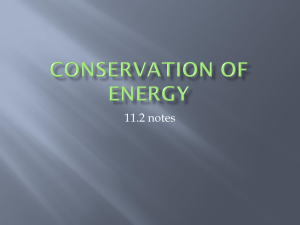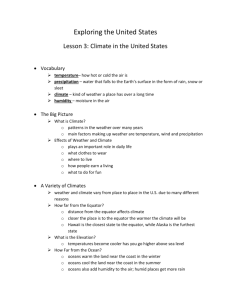APPLICATIONS OF SINUSOIDS 1. Will Rogers spun a lasso in a
advertisement
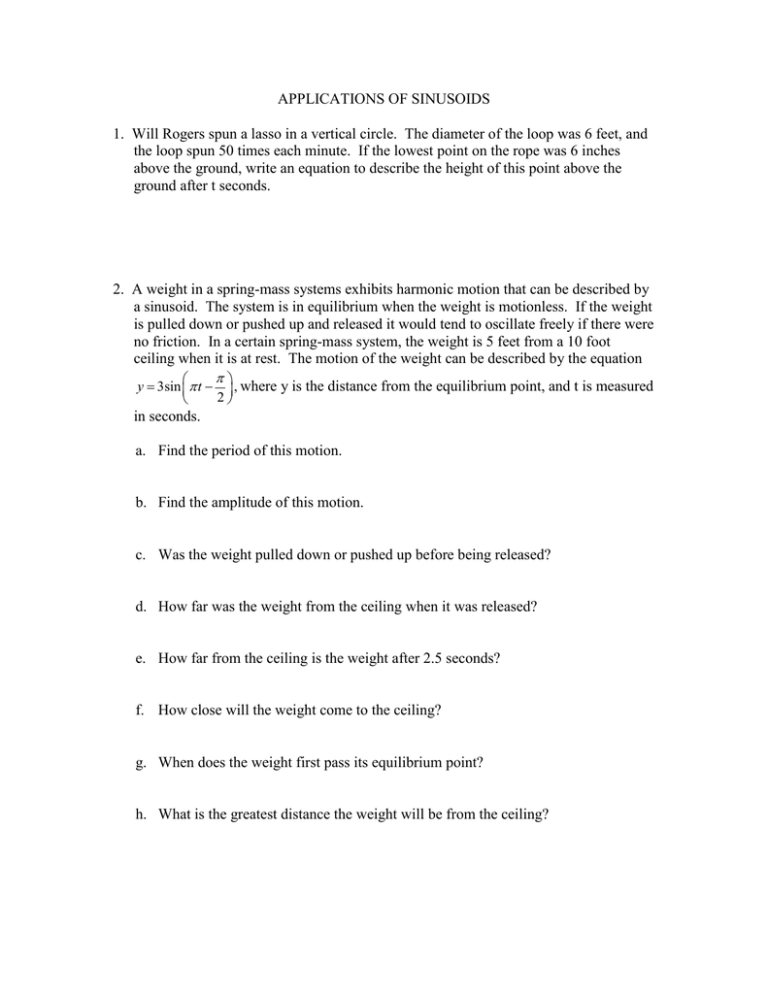
APPLICATIONS OF SINUSOIDS 1. Will Rogers spun a lasso in a vertical circle. The diameter of the loop was 6 feet, and the loop spun 50 times each minute. If the lowest point on the rope was 6 inches above the ground, write an equation to describe the height of this point above the ground after t seconds. 2. A weight in a spring-mass systems exhibits harmonic motion that can be described by a sinusoid. The system is in equilibrium when the weight is motionless. If the weight is pulled down or pushed up and released it would tend to oscillate freely if there were no friction. In a certain spring-mass system, the weight is 5 feet from a 10 foot ceiling when it is at rest. The motion of the weight can be described by the equation y 3sin t , where y is the distance from the equilibrium point, and t is measured 2 in seconds. a. Find the period of this motion. b. Find the amplitude of this motion. c. Was the weight pulled down or pushed up before being released? d. How far was the weight from the ceiling when it was released? e. How far from the ceiling is the weight after 2.5 seconds? f. How close will the weight come to the ceiling? g. When does the weight first pass its equilibrium point? h. What is the greatest distance the weight will be from the ceiling? 3. The number of hours of daylight in one year in Ellenville can be modeled by a sinusoidal function. During 2006, the longest day occurred on June 21 with 15.7 hours of daylight. The shortest day of the year occurred on December 21 with 8.3 hours of daylight. Write a sinusoidal equation to model the hours of daylight in Ellenville. 4. In predator-prey situations, the number of animals in each category tends to vary periodically. A certain region has pumas as predators and deer as prey. The number of pumas varies with time according to the function P 200sin(0.4t 0.8) 500 and the number of deer varies according to the function D 400sin 0.4t 1500 with time t, in years. a. How many pumas and deer will there be in the region in 15 years? b. What is the maximum population of the pumas? When does this occur? What is the minimum population of the pumas? When does this occur? c. What is the maximum population of the deer? When does this occur? What is the minimum population of the deer? When does this occur? d. Using graphs of these two equations, make a statement regarding the relationship between the number of puma and the number of deer. 5. A satellite is deployed from a space shuttle into an orbit which goes alternately north and south of the equator. Its distance from the equator over time can be approximated by a sine wave. It reaches 4500km, its farthest point north of the equator, 15 minutes after the launch. Half an orbit later, it is 4500km south of the equator, its farthest point south. One complete orbit takes 2 hours. a. Find an equation of a sinusoidal function that models the distance of the satellite from the equator. b. How far away from the equator is the satellite 1 hour after launch? 6. Tarzan is swinging back and forth on his grapevine. As he swings, he goes back and forth across the riverbank, going alternately over land and water. Jane decies to model his movement mathematically and starts her stopwatch. Let t be the number of seconds the stopwatch reads and let y be the number of meters Tarzan is from the riverbank. Assume that y varies sinusoidally with t and that y is positive when Tarzan is over water and negative when he is over land. Jane finds that when t=2 Tarzan is at the end of his swing, where y=-23. She finds that when t=5 he reaches the other end of the swing and y=17. a. Sketch a graph of this function. b. Write an equation expressing Tarzan’s distance from the river bank in terms of t. c. Find y when t=2.8, t=6.3, and t=1.5. d. Where was Tarzan when Jane started her stopwatch? 7. A pet store clerk noticed that the population in the gerbil habitat varied sinusoidally with respect to time in days. He carefully collected data and graphed his resulting equation. From the graph, determine the amplitude, period, phase shift and vertical shift of the graph. Write the equation of the graph. 8. The temperature in an office is controlled by an electronic thermostat. The 11 temperatures vary according to the sinusoidal function: y 6sin x 19 12 12 where y is the temperature (◦C) and x is the time in hours past midnight. a. What is the temperature in the office at 9AM when the employees come to work? b. What are the maximum and minimum temperatures in the office? 9. A team of biologists have discovered a new species in the rain forest. They note the temperature of the animal appears to vary sinusoidally over time. A maximum temperature of 125◦ occurs 15 minutes after they start their examination. A minimum temperature of 99◦ occurs 28 minutes later. The team would like to find a way to predict the animal’s temperature over time in minutes. Your task is to help them by creating a graph of one full period and an equation of temperature as a function over time in minutes. 10. The angle of inclination of the sun changes throughout the year. This changing angle affects the heating and cooling of buildings. The overhang of the roof of a house is designed to shade the windows for cooling in the summer and allow the sun’s rays to enter the house for heating in the winter. The sun’s angle of inclination at noon in central New York state can be modeled by the formula 3600 360 Angle of Inclination (in degrees) 23.5cos x 47 , where x is the number 365 365 of days elapsed in the year, with January 1 represented by x=1, January second represented by x=2, and so on. a. Find the sun’s angle of inclination on Valentine’s Day. b. On what date of the year is the angle of inclination at noon the greatest?
